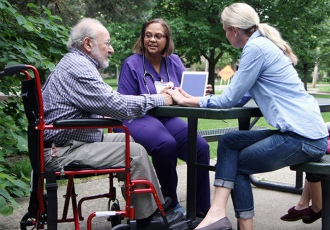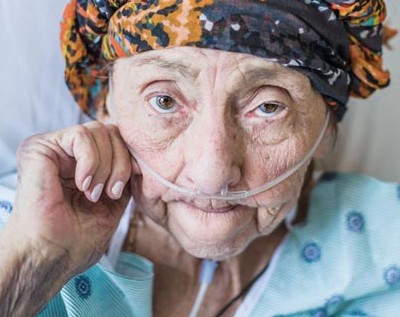5 Best Practices for Providing Culturally Sensitive Care
What is culturally sensitive care?
Culturally sensitive care incorporates the perspectives, beliefs, traditions, and circumstances of diverse communities built around shared heritages. When practiced appropriately, culturally sensitive care ensures patients’ unique needs and preferences are met, regardless of cultural differences between patient and healthcare professional.
After all, caring for someone whose culture is different from your own can be intimidating. And caring for patients with advanced illnesses can be especially sensitive: Unfamiliar perspectives or cultural norms about death and dying can quickly remind us how much we have to learn.
No healthcare professional wants to feel ignorant, incapable, or imposing—especially during such a difficult period in a person’s life. We can take steps to ensure every patient and family receives culturally sensitive care that supports their comfort and dignity.
Check out these five tips from VITAS experts on providing care that honors your patient’s unique beliefs, preferences, and cultural values.
1. Start with a conversation
For patients with advanced illness, a goals-of-care (GOC) conversation is a crucial step toward understanding their preferences for care near the end of life. The trick is to have these conversations early and matter-of-factly—and to have them regularly over the course of the patient’s illness.
These conversations also offer great opportunities to learn about a patient’s cultural identity, including their religious beliefs, traditions, and rites surrounding death. A simple question reveals so much: “What does comfort mean to you or your loved one?”
GOC conversations might also provide insight into a patient’s home life. Members of multigenerational households—in which two or more generations of adults live together—may feel that they or their aging loved one has all the care they need at home. This is a chance to explain how comfort-focused hospice or palliative care can support their caregiving relationship, especially as a patient’s symptom management needs intensify. Conversations can create more time for meaningful connection.
“In most Asian cultures, including Indian culture, when a senior parent gets sick, the [adult children] feel an obligation to keep the parents at home and give them the love and care they need,” says Birinder Marwah, MD, a medical director for VITAS in the Chicago area. “Yes, a family can provide help to a patient in terms of psychosocial support. But in hospice, we have a whole lot of separate knowledge of how to control and manage symptoms, and even many physicians don’t know these things.”
Even when symptom management needs are minimal, Dr. Marwah points out, “not all... families have the wherewithal or financial background to bring a needy, dying person into their home.”
2. Listen, don’t assume
Whether or not you were involved with a patient’s GOC conversation, there’s always more to learn about their needs and preferences. Certain details might have been left out of an initial GOC discussion. Maybe the patient’s goals have evolved. Routinely ask the patient and their caregiver/family if you’re missing something, or if you could be doing anything to make their medical care align better with their ideal.
Knowingly or not, we all tend to have some preconceptions and biases about a patient’s ethnicity, age, national origin, gender, or religion. Limit your assumptions about how these factors affect a person’s preferences for care.Instead, use your existing knowledge to ask better questions. Then incorporate the answers into your care of the patient and their family, demonstrating that their needs and preferences are heard.
Bear in mind that the needs of the patient and the needs of the family may differ, requiring increased sensitivity when discussing care options.
“In many immigrant cultures... it’s not that hospice is quote-unquote taboo, it’s that they feel their culture is taboo to hospice,” says Sunil Pandya, MD, associate medical director in Collier County, Florida. “We don’t know if hospice knows what we want.”
“You have to personalize your touch,” he adds. “Take a barometer—not an assumption—of [the patient’s culture and spirituality].”
3. Research end of life cultural practices
Once you better understand who your patient is and have identified their preferences for care, do some additional research.
Consider how a patient’s generational status may intersect with their national origin or ethnic community. If you know your patient lived overseas when they were younger, look into the regional politics and major events of the time.
For instance: “In the Vietnamese community... most of the people came here from Communism. We never had this kind of service, so [hospice] comes across as too good to be true,” says Tiffany Phuong, admissions liaison in Orange County, California. “It just hasn’t been explained in the right way.”
Again, avoid making assumptions about an individual, no matter how well-informed or well-intentioned you are. With a little research, it’s easier to anticipate and address issues before they arise. Plus, your knowledge can help a patient feel confident in what they might otherwise see as a risky decision to elect hospice care.
Dr. Marwah refers to this approach as “answering the telephone before it rings.”
“You know the ethnicity of this family, you know their religion. When we get these patients on our service,” he says, “it is paramount that we take all of those things into account and assure patients and families that their needs will be met.”
4. Seek support when you need it
While you’re likely able to perform many parts of your role without assistance, it’s OK to ask for help if you feel overwhelmed.
If you’re facing a language barrier, see if a member of your organization can help translate. For instance, VITAS offers a translator service for all members of its staff.
If a patient seems hesitant to discuss certain needs with you, consider inviting another member of your team to be present during a visit. You might even reach out to a local medical association or cultural organization for guidance. In some cases, patients may be more willing to open up to someone who feels familiar to them.
“Diversity in hiring is obviously important,” says Robert Nguyen, medical director in Orange County. “Having someone of the same or similar ethnic or religious background can help lay the foundation for trust in the relationship. Many patients and families appreciate being able to relate to staff culturally and spiritually.”
Related: How Diversity Shapes the Care and Culture of VITAS >
5. Accommodate wherever possible
When discussing care options with patients near the end of life and their families, you must embrace the needs of people and cultures who may be unfamiliar with the benefits of hospice and palliative care, rather than expecting them to adapt to the standards you’ve long maintained. In certain parts of the world, comfort care is associated with poorly maintained facilities or places where the elderly are left to die. In others, this sort of care is nonexistent.
Think about all the ways, small and large, that you can make a difference for a patient and their family during every visit. Consider how you can change your approach to care to help a patient feel seen, understood, and honored. Practice patience during uncomfortable conversations, and always seek opportunities to learn more about the patient’s needs through questions and observation.
“When we show that hospice can be sensitive to these needs, not only are we helping families make the right decision, but we’re creating partners who can go back into the community to talk about the benefits of our services,” says Dr. Marwah. “I tell my team all the time, these families are ambassadors for hospice.”

Tips for Effective Goals-of-Care Discussions
Conduct more effective goals-of-care discussions with your patients by using this conversation starter guide.
Download the PDF Clinicians: Receive Our Newsletters
